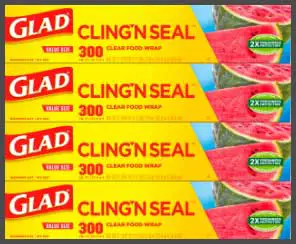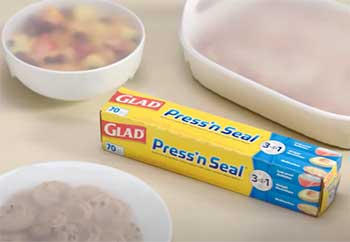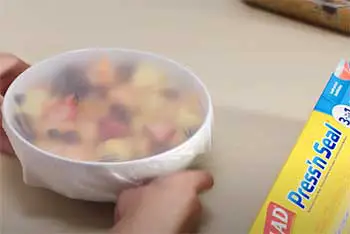Kitchen wraps like Cling’n Seal and Press ‘n Seal have become necessity for freshness. We depend on them to keep our food air-tight and protected. But with so many options on the grocery store shelf, how do you decide what is best?
In this comprehensive guide, we’ll explore the key differences, pros and cons of these two top plastic wraps. You’ll learn how they compare on metrics like adaptability, durability, and ease of use so can determine what is right for your needs.
A Brief Comparison Table
| Metric | Cling’n Seal | Press ‘n Seal |
| Thickness | Thin, flexible plastic | Thicker plastic with air bubble texture |
| Sealing Method | Static cling | Pressure sensitive adhesive |
| Key Strength | Conforms to smooth surfaces, self-sealing | Molds to irregular shapes, freezer durable |
| Tear Ability | Serrated edge tears easily | Must manually tear |
| Odor Resistance | Resists stains and odors | Retains odors and stains |
| Recyclability | More widely recycled | Limited recycling options |
| Storage | Rolls for compact storage | Boxes take up more space |
| Dispensing | Difficult – falls back on itself | Easy – adhesive keeps wrap handy |
| Availability | Sold in most stores | Less widely available |
| Price Per Area | Approximately 2¢ per sq. ft. | 4-5¢ per sq. ft. |
Overview of Cling’n Seal and Press ‘n Seal
First, let’s level set on what each product offers.
- What is Cling’n Seal?

Cling’n Seal is a thin, transparent plastic wrap that clings to containers and itself to create an airtight seal.
The serrated side allows you to easily tear off sheets of the desired size.
It was originally made from polyvinyl chloride (PVC) but today is produced from polyethylene to make it more environmentally friendly.
Cling’n Seal is best for wrapping foods for the fridge and covering leftovers. The thin plastic nicely contours bowls, plates, jars lids, and more to keep contents fresh. It excels at sticking to smooth surfaces and itself to fully seal in contents.
- What is Press ‘n Seal?
Press ‘n Seal is also a plastic wrap but differs in that it has little air bubbles that give it more structure and thickness. Rather than clinging, it uses pressure-sensitive adhesives that firmly sticks when pressed on surfaces like containers or itself.
Press ’n Seal is versatile for fridge and freezer use. The textured surface helps it adhere better to irregular shapes like produce, meats, baked goods and more. The thicker plastic also makes it more durable and better suited for messy tasks.
Key Differences Between Cling’n Seal And Press ‘n Seal Plastic Wraps

Now that you know the basics, let’s compare them head-to-head.
- Ease of Use
For those short on time or patience in the kitchen, ease of use is key.
Cling’n Seal tears off easily in neat sheets so you can quickly wrap up leftovers or cover containers. It effortlessly clings to smooth surfaces and itself using static electricity. This makes covering a bowl or tray fast and frustration-free.
However, for irregular shapes, you’ll have to carefully wrap multiple sheets so it contours and seals properly. Too few sheets won’t provide full coverage while too many creates inconvenient bunching.
Press ’n Seal takes a bit more effort as the thicker plastic is less malleable. You have to smoothly press out any air bubbles between the wrap and contents to get it to adhere correctly. But it excels at clinging to uneven shapes in a single sheet, especially if you take time to mold it thoroughly.
So for quickly sealing standard containers, Cling’n Seal wins for convenience while Press ’n Seal requires more finesse. But for securely wrapping produce, meats, and baked goods, Press ’n Seal’s moldability gives it the advantage.
- Adaptability
Food comes in endless shapes and sizes these days. An adaptable wrap is essential whether you’re covering a steaming lasagna, an odd-shaped veggie, or anything in between.
Cling’n Seal only does well wrapping smooth, relatively flat items thanks to its ultra thin plastic. Any contours or grooves make it hard for the serrated side to seal correctly. Unless you want to waste sheets reheating it to shrink perfectly, it can be tricky getting it to contour.

But Press ’n Seal’s raised air bubble texture lets it adapt better.
You can press it into nooks and crannies so oxygen is fully expelled.
It will stick decently to most clean surfaces from glassware to Tupperware to itself without bunching up.
The only exceptions are surfaces that repel adhesives like waxy produce skins and certain porous plastics.
So if you regularly wrap lots of uneven leftovers or freezer items, then Press ’n Seal’s superior adaptability is a major perk. But if you mostly just cover smooth bowls, then the hassle-free cling of Cling’n Seal gets the job done.
- Durability
Plastic wraps see all kinds of abuse from messy foods, extreme temperatures, microwave radiation, and more. A durable wrap is critical so you avoid the mess of spills, leaks, and contamination destroying your precious leftovers.
Thanks to Cling’n Seal’s thin plastic, it succumbs to wear easily especially along frequently used serrated edges. It can tear when stretched too far over large containers allowing air seepage. Temperature swings in the fridge also reduce cling ability over time. And the thin plastic offers less insulation against freezer burn.
In contrast, Press ’n Seal stands up well to regular kitchen punishment. The textured plastic stretches without tearing to snugly fit more vessels and withstand temperature shifts. Contents stay securely sealed despite heavy usage and washing.
It also insulates better against freezer burn thanks to the thicker plastic. Microwaving does compromise adhesive bonds with prolonged heating however.
So for minimizing waste and keeping food fresher longer despite heavy duty use, Press ’n Seal is the clear winner here. Cling’n Seal works fine for covering typical leftovers that get eaten quickly.
But for long-term storage and freezing, Press ’n Seal’s durability provides superior protection.
- Odor and Stain Resistance
Let’s face it – plastic wraps get pretty gross pretty fast. Rich curries, pungent cheeses, messy marinades, and mystery spills in the fridge quickly lead to stinky, stained wraps. An odor and stain resistant wrap keeps things sanitary and your fridge air fresh.
The slick surface of Cling’n Seal minimizes porous absorption of odors, flavors, and fats. Most residue wipes away cleanly with soap and water without staining too.
But Press ’n Seal’s textured bubbles retain smells and discoloration more stubbornly despite vigorous scrubbing. Harsh cleaners are needed to penetrate crevasses which can degrade adhesive effectiveness over time.
So if resisting odors and stains is important to you, then Cling’n Seal is the better choice. Washing Press ’n Seal can be tedious and still leave wraps looking dirty. But if you aren’t too picky about appearances, Press ’n Seal’s stronger seals outweigh cleanliness issues for most folks.
- Environmentally Friendly
Plastics pose significant waste problems and consumers today care about eco-friendly options with their purchases.
Traditional PVC Cling’n Seal wrap took ages break down in landfills leaching harmful chemicals. So most manufacturers including Glad now produce polyethylene versions more easily recycled and safer for the environment.
Press ’n Seal also utilizes polyethylene but the multilayer plastic-adhesive combination makes it tougher to recycle economically. And fewer facilities accept it compared to grocery store bags and resealable food wraps.
Neither wrap can be composted despite containing plant starches unfortunately. So responsible disposal depends heavily on what recyclers in your neighborhood accept. Check locally if either wrap is recyclable curbside before purchasing to make the best green choice for your area.
- Cost Comparison
Besides performance, long-term costs impact wrap choices for economically minded folks. Price per square foot provides the best cost comparison between wraps.

Cling’n Seal currently averages about 2 cents per square foot based on typical pricing for standard 200 square foot rolls.
Press ’n Seal runs 4 to 5 cents per square foot normally for 175 square foot boxes.
So you’ll spend two to three times more for Press ’n Seal per area wrapped.
But improved durability often makes it last over twice as long through repeated usage. So if you do high volume wrapping, it can pencil out cost neutral overall.
Just beware cheaper generic versions that mimic big brands. Quality control issues lead to premature failure regardless of tempting prices. Sticking with trusted names like Glad and Reynolds ensures reliable performance worthy of extra upfront costs.
- Convenience Factors
Beyond basic functionality, convenience factors like storage, dispensing, and availability also determine satisfaction wrapping leftovers in the kitchen.
Cling’n Seal offers compact storage neatly rolling out from under counters or drawers. The vertical serrated cutter along most boxes simplifies tearing off sizeable sheets one-handed when your other hand is occupied. Plus being an classics staple, it is widely available from big box stores to corner bodegas.
Press ’n Seal does take up bit more space in a box format rather than rolled sheets. Standard boxes lack built-in cutters requiring you to manually tear sheets. And fewer smaller shops stock it routinely compared to ultra-common Cling’n Seal.
However, Press ’n Seal makes up for minor storage and availability drawbacks by being significantly easier to dispense. The adhesive clings neatly to edge of boxes when you remove sheets preventing annoying roll back.
In contrast, Cling’n Seal falls limply back on itself the second you tear sheets requiring two hands manage.
So convenience favors Cling’n Seal for accessibility and storage while Press ’n Seal wins for hassle-free sheet dispensing.
Frequently Asked Questions (FAQ)
Yes, Glad and other major brands of press ‘n seal style wrap are safe for direct food contact. The clingy plastic plus airtight seal keeps wrapped contents fresh. Press ‘n seal works well for leftovers, produce, meats, cheeses and more whether storing in fridge or freezer. Just avoid microwaving press ‘n seal directly as prolonged heat exposure reduces adhesive effectiveness over time.
Press ‘n seal can adhere decently to smoother plastics like Tupperware and plastic deli containers provided surfaces are clean. Avoid porous absorbent plastics that resist adhesive bonding. Ensure the entire inner surface makes contact smoothing out any wrinkles for an airtight seal. Check periodically while storing that edges remain tightly fused as temperature fluctuations can reduce cling to plastic over time compared to glass.
Glad Cling Wrap as it was previously known got rebranded in 2008 as Glad Cling’n Seal to better differentiate from competitors also using “cling wrap” generically. The new Cling’n Seal name aligned better with Glad’s other food wrap products. Otherwise the standard cling wrap we all know hasn’t changed beyond gradual improvements in strength, cling ability and environmental friendliness shifting away from PVC materials. So you can still depend on Glad for keeping leftovers sealed fresh!
Glad is one of the most popular brand names for cling wrap – the thin plastic film that adheres to itself and bowls via static cling to seal in leftovers. But “cling wrap” has become a generic term used interchangeably for any brand of plastic wrap utilizing cling properties without need for adhesives. However most other brands use less effective clings compared to market leader Glad so pay attention to actual names on packaging if cling ability is important to your usage. Essentially Glad wrap utilizes the highest grade cling wrap technology setting the standard.
Final Takeaways
Cling’n Seal and Press ‘n Seal both offer quality food sealing performance that has improved with recent innovations. Which option works best comes down your specific kitchen needs:
- Cling’n Seal remains the fastest, most adaptable wrap provided contents are relatively smooth and used soon after covering. It works great for standard leftovers and glassware thanks to easy cling and disposability.
- Press ’n Seal excels when securely wrapping irregular shapes like produce, baked goods, and meats needed for extended storage. The moldable textured plastic and durability keep contents air-tight despite heavy usage over time.
When comparing costs, Press ’n Seal does carry a higher price tag but its increased longevity balances spending over the long run. And while Cling’n Seal offers better storage and availability currently, Press ’n Seal’s effortless box dispensing provides superior convenience dispensing sheets one-handed.
Hopefully scrutinizing the pros and cons gives clarity deciding between these plastic wrap heavyweights. Now you can determine the ideal solution to keep your fridge foods perfectly fresh for your lifestyle!

